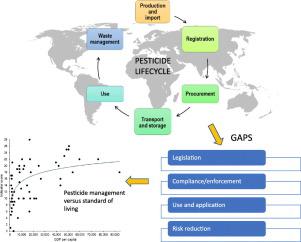Science of the Total Environment ( IF 8.2 ) Pub Date : 2020-06-30 , DOI: 10.1016/j.scitotenv.2020.140598 Henk van den Berg 1 , Baogen Gu 2 , Beatrice Grenier 2 , Eva Kohlschmid 2 , Samira Al-Eryani 3 , Haroldo Sergio da Silva Bezerra 4 , Bhupender N Nagpal 5 , Emmanuel Chanda 6 , Elkhan Gasimov 7 , Raman Velayudhan 8 , Rajpal S Yadav 8

|
Pesticide lifecycle management encompasses a range of elements from legislation, regulation, manufacturing, application, risk reduction, monitoring, and enforcement to disposal of pesticide waste. A survey was conducted in 2017–2018 to describe the contemporary global status of pesticide lifecycle management, to identify where the gaps are found. A three-tiered questionnaire was distributed to government entities in 194 countries. The response rate was 29%, 27% and 48% to the first, second and third part of the questionnaire, respectively. The results showed gaps for most of the selected indicators of pesticide management, suggesting that pesticide efficacy and safety to human health and the environment are likely being compromised at various stages of the pesticide lifecycle, and at varying degrees across the globe. Low-income countries generally had the highest incidence of gaps. Particular shortcomings were deficiencies in pesticide legislation, inadequate capacity for pesticide registration, protection against occupational exposure to pesticides, consumer protection against residues in food, and environmental protection against pesticide contamination. Policy support for, and implementation of, pesticide use-reduction strategies such as integrated pest management and integrated vector management has been inadequate across regions. Priority actions for structural improvement in pesticide lifecycle management are proposed, including pesticide use-reduction strategies, targeted interventions, and resource mobilization.
中文翻译:

农业和公共卫生中农药的生命周期管理:差距在哪里?
农药的生命周期管理涵盖了从立法,法规,制造,应用,降低风险,监控和执行到农药废物处置的一系列要素。2017-2018年进行了一项调查,描述了当今农药生命周期管理的全球现状,以找出差距所在。向194个国家的政府实体分发了三层调查表。问卷第一部分,第二部分和第三部分的答复率分别为29%,27%和48%。结果表明,大多数选定的农药管理指标均存在差距,表明在农药生命周期的各个阶段以及全球范围内,农药的功效以及对人类健康和环境的安全性都可能受到损害。低收入国家的差距率通常最高。特别的缺点是农药立法方面的缺陷,农药注册能力不足,对农药职业接触的防护,对食品残留物的消费者保护以及对农药污染的环境保护。在各个区域,对减少农药使用的战略(如虫害综合防治和病媒综合治理)的政策支持和实施不足。提出了在农药生命周期管理中改善结构的优先措施,包括减少农药的使用策略,有针对性的干预措施和资源动员。农药注册的能力不足,针对农药的职业暴露的防护,针对食品中残留物的消费者保护以及针对农药污染的环境保护。在各个区域,对减少农药使用的战略(如虫害综合防治和病媒综合治理)的政策支持和实施不足。提出了在农药生命周期管理中改善结构的优先措施,包括减少农药的使用策略,有针对性的干预措施和资源动员。农药注册的能力不足,针对农药的职业暴露的防护,针对食品中残留物的消费者保护以及针对农药污染的环境保护。在各个区域,对减少农药使用的战略(如虫害综合防治和病媒综合治理)的政策支持和实施不足。提出了在农药生命周期管理中改善结构的优先措施,包括减少农药的使用策略,有针对性的干预措施和资源动员。减少害虫使用的战略,例如病虫害综合防治和病媒综合防治,在各个区域都不够。提出了在农药生命周期管理中改善结构的优先措施,包括减少农药的使用策略,有针对性的干预措施和资源动员。减少害虫使用的战略,例如病虫害综合防治和病媒综合防治,在各个区域都不够。提出了在农药生命周期管理中改善结构的优先措施,包括减少农药的使用策略,有针对性的干预措施和资源动员。











































 京公网安备 11010802027423号
京公网安备 11010802027423号